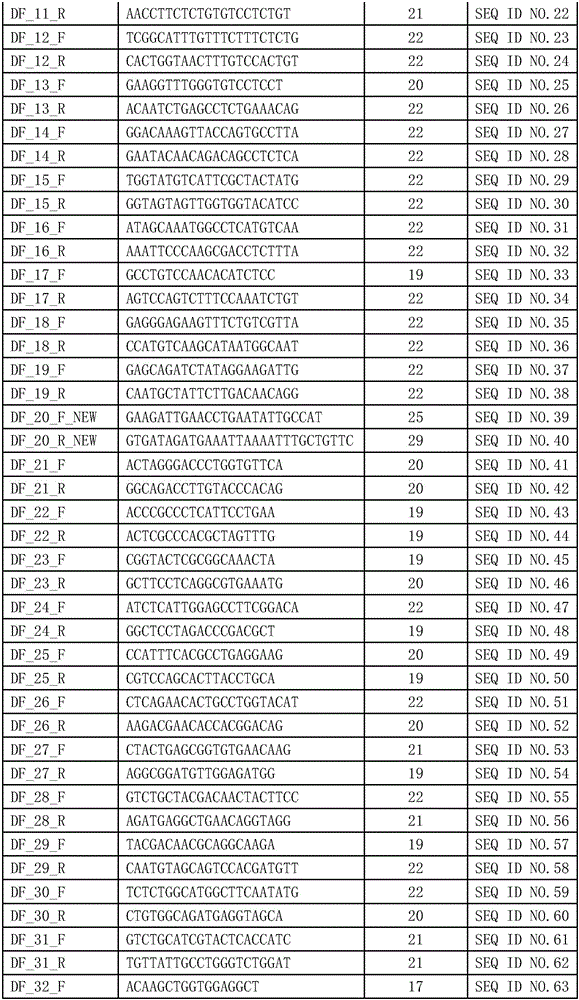Nucleic acid sequence for detecting deaf genes and applications thereof
A deafness gene and nucleotide sequence technology, applied in the field of gene sequencing and biological testing, can solve the problems of time-consuming, laborious, high cost, and difficulty in detecting different mutation sites of multiple genes at the same time, and achieve low-cost effects
- Summary
- Abstract
- Description
- Claims
- Application Information
AI Technical Summary
Problems solved by technology
Method used
Image
Examples
Embodiment 1
[0066] Example 1: Extracting DNA from Whole Blood Samples
[0067] 1) Take the sample out of the refrigerator at -20°C, dissolve it at room temperature, and turn on the water bath and set it to 56°C.
[0068] 2) Add 20ul of proteinase K to a 1.5ml centrifuge tube, add 200ul of fully dissolved whole blood (mix by inverting before use), shake and mix, and centrifuge for a short time to remove droplets on the inner wall of the tube.
[0069] 3) Add 200 ul buffer solution GB, vortex to mix, and centrifuge for a short time to remove the liquid droplets on the inner wall of the tube. Put the centrifuge tube in a water bath at 56° C. for 10 min, and shake the sample gently from time to time.
[0070] 4) Take the centrifuge tube out of the water bath, let it cool slightly, add 200ul absolute ethanol, shake and mix well, centrifuge for a short time and let it stand at room temperature for 3 minutes.
[0071] 5) Transfer the above mixed solution into the adsorption column CR2. Care sho...
Embodiment 2
[0079] Embodiment 2: multiplex PCR amplification
[0080] Using the DNA obtained in Example 1 as a template, multiplex PCR amplification was performed.
[0081] The multiplex PCR reaction system described therein is a 25ul system, and the specific reaction system and reaction procedures are shown in Table 4 and Table 5. The "multiple PCR primers" are primer pools, see Table 1 and Table 2.
[0082] Table 4: Reaction system of primer pool ID No: 1-primer pool ID No: 4
[0083] serial number
Volume (ul)
1
template DNA
2
2
rTaq polymerase
0.2
3
10X PCR buffer
2.5
4
dNTP Mixture (2.5mM)
2
5
Multiplex PCR Primers (100uM)
4
6
Sterile distilled water
14.3
Total
25
[0084] Table 5: Reaction system of primer pool ID No: 5-primer pool ID No: 8
[0085] serial number
Volume (ul)
1
template DNA
2
2
...
Embodiment 3
[0089] Example 3: Library Preparation
[0090] The PCR products obtained in Example 2 were mixed and purified using Agencourt AMPure XP-Nucleic Acid Purification Kit. The purified product was prepared for library preparation, and the library preparation steps were as follows:
[0091] 1. End repair
[0092] Table 7: End repair reaction system
[0093]
[0094] After the reaction system was shaken and centrifuged, it was incubated at room temperature for 20 min. After incubation, use AgencourtAMPure XP-Nucleic Acid Purification Kit for purification, and finally dissolve in 27ul nuclease-free water.
[0095] 2. Joint connection
[0096] Table 8: Linker Ligation Reaction System
[0097]
[0098] After the adapter ligation reaction mixture was shaken and centrifuged, it was placed on a PCR machine and incubated at 25°C for 15 minutes and at 72°C for 5 minutes. After incubation, use Agencourt AMPure XP-Nucleic Acid Purification Kit for purification, and finally dissolve...
PUM
 Login to View More
Login to View More Abstract
Description
Claims
Application Information
 Login to View More
Login to View More - R&D
- Intellectual Property
- Life Sciences
- Materials
- Tech Scout
- Unparalleled Data Quality
- Higher Quality Content
- 60% Fewer Hallucinations
Browse by: Latest US Patents, China's latest patents, Technical Efficacy Thesaurus, Application Domain, Technology Topic, Popular Technical Reports.
© 2025 PatSnap. All rights reserved.Legal|Privacy policy|Modern Slavery Act Transparency Statement|Sitemap|About US| Contact US: help@patsnap.com



